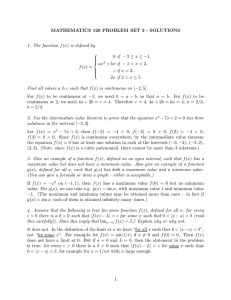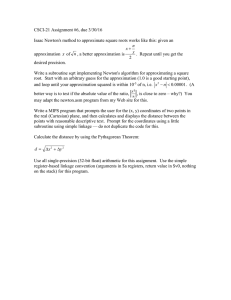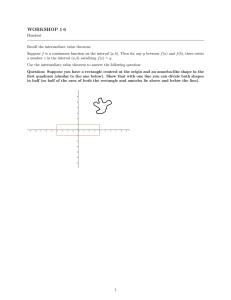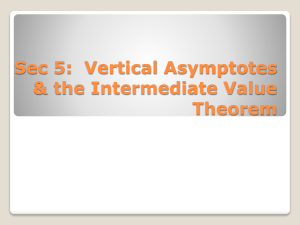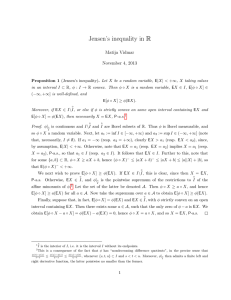Math 1210 Quiz 7 March 7th, 2014
advertisement
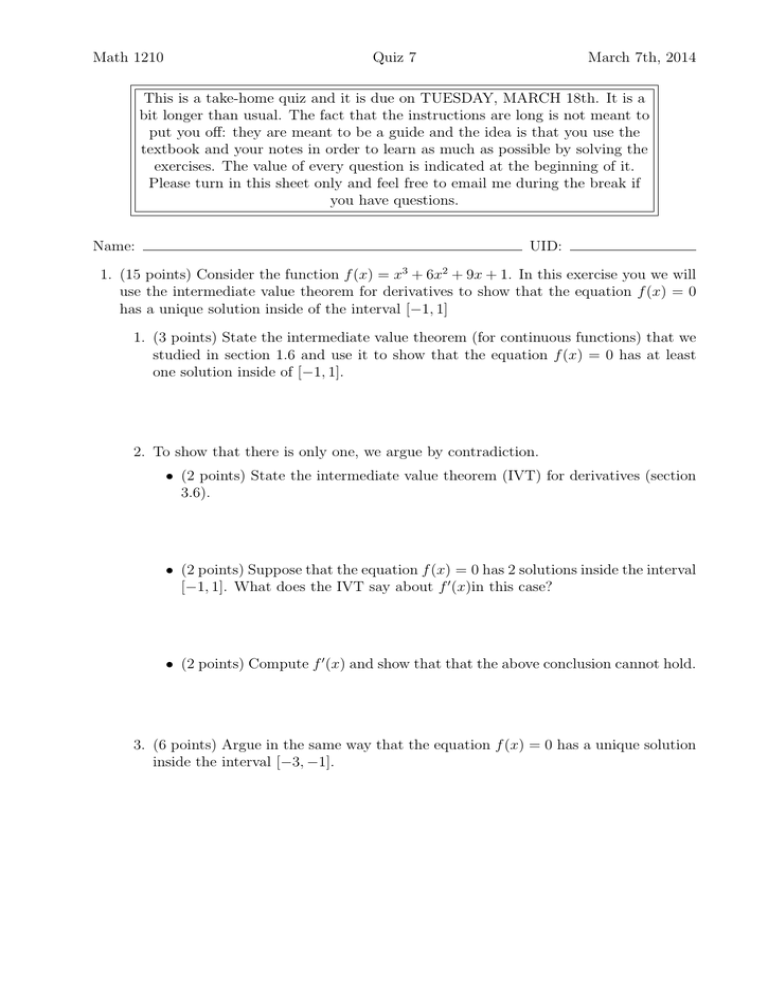
Math 1210 Quiz 7 March 7th, 2014 This is a take-home quiz and it is due on TUESDAY, MARCH 18th. It is a bit longer than usual. The fact that the instructions are long is not meant to put you off: they are meant to be a guide and the idea is that you use the textbook and your notes in order to learn as much as possible by solving the exercises. The value of every question is indicated at the beginning of it. Please turn in this sheet only and feel free to email me during the break if you have questions. Name: UID: 1. (15 points) Consider the function f (x) = x3 + 6x2 + 9x + 1. In this exercise you we will use the intermediate value theorem for derivatives to show that the equation f (x) = 0 has a unique solution inside of the interval [−1, 1] 1. (3 points) State the intermediate value theorem (for continuous functions) that we studied in section 1.6 and use it to show that the equation f (x) = 0 has at least one solution inside of [−1, 1]. 2. To show that there is only one, we argue by contradiction. • (2 points) State the intermediate value theorem (IVT) for derivatives (section 3.6). • (2 points) Suppose that the equation f (x) = 0 has 2 solutions inside the interval [−1, 1]. What does the IVT say about f 0 (x)in this case? • (2 points) Compute f 0 (x) and show that that the above conclusion cannot hold. 3. (6 points) Argue in the same way that the equation f (x) = 0 has a unique solution inside the interval [−3, −1]. 2. (15 points) Consider again the function f (x) = x3 + 6x2 + 9x + 1. 1. (1 point) What is the domain of f ? 2. (2 point) Compute the limits limx→+∞ f (x) and limx→−∞ f (x). 3. (4 points) Over which intervals is f increasing (resp. decreasing)? Namely, for which x is f 0 (x) positive (resp. negative)? 4. (2 points) What are, if any, the local extreme values of f ? 5. (4 points) Over which intervals is f concave up (resp. down)? Namely, for which x is f 00 (x) positive (resp. negative)? 6. (2 points) What are, if any, the inflection points of f ? 7. (4 points) Sketch the graph of f . 8. Check that your computations and your graph are consistent with the conclusions of Exercise 1. Page 2 3. (15 points) Consider again the function f (x) = x3 + 6x2 + 9x + 1. You have shown in Exercise 1 that the equation f (x) = 0 has a (unique) solution inside of [−1, 1]. Use Newton’s method to find an approximation of it which is accurate to 5 decimal places. 1. (6 points) Recall that, starting from an appropriate initial approximation x1 , Newton’s method provides a sequence of points x2 , x3 , . . . that converges towards the solution of the equation. Starting with x1 = 2, fill in the following table until |xn − xn−1 | < 0.00001 (6 steps will be enough). n xn = xn−1 − 1 x1 = 2 f (xn−1 ) f 0 (xn−1 ) |xn − xn−1 | − 2 x2 = |x2 − x1 | = 3 x3 = |x3 − x2 | = 4 x4 = |x4 − x3 | = 5 x5 = |x5 − x4 | = 6 x6 = |x6 − x5 | = 2. (1 point) Why was it a good idea to use x1 = 2 as an initial approximation? 3. (2 points) Draw a sketch of the function f (x) and the first few x-values x1 , x2 , x3 produced by Newton’s method (with the tangent lines that the method uses to find them). Page 3 4. (6 points) Now take x1 = −1.5 as your initial approximation and run Newton’s method again (fill in the table below). What is the output of the algorithm in this case? What feature of f do you think explains this (look at the graph for f (x) that you sketched in Exercise 2). n xn = xn−1 − 1 x1 = −1.5 f (xn−1 ) f 0 (xn−1 ) |xn − xn−1 | − 2 x2 = |x2 − x1 | = 3 x3 = |x3 − x2 | = 4 x4 = |x4 − x3 | = 5 x5 = |x5 − x4 | = Page 4

![1 = 0 in the interval [0, 1]](http://s3.studylib.net/store/data/007456042_1-4f61deeb1eb2835844ffc897b5e33f94-300x300.png)
